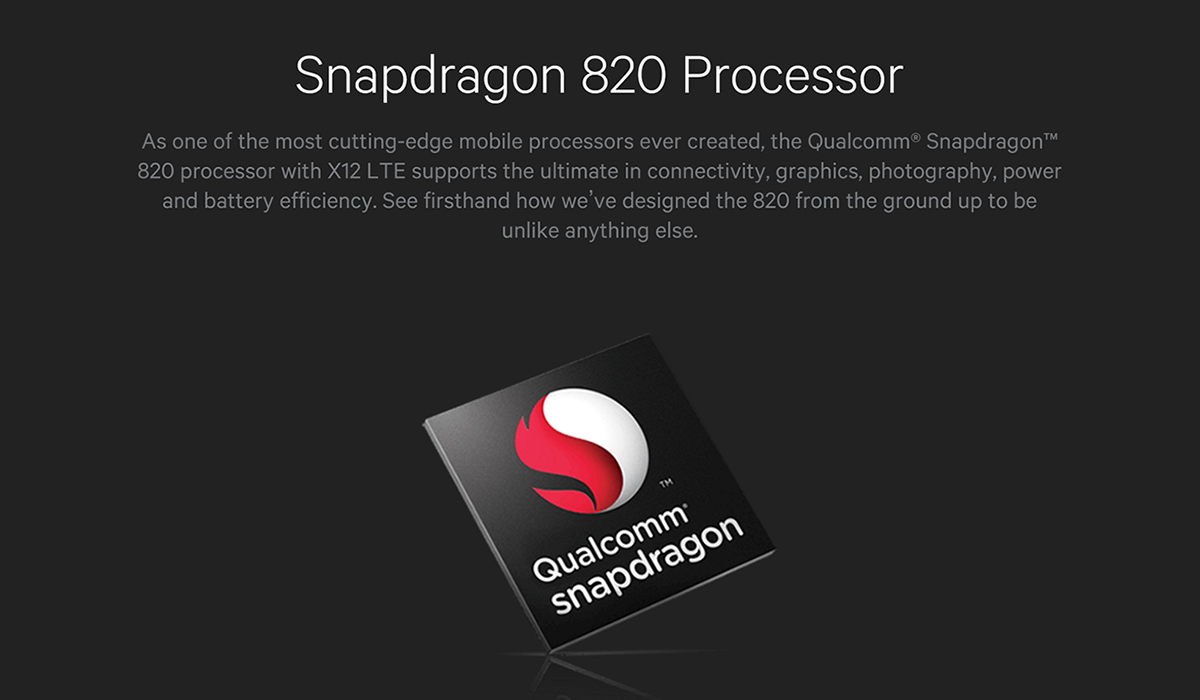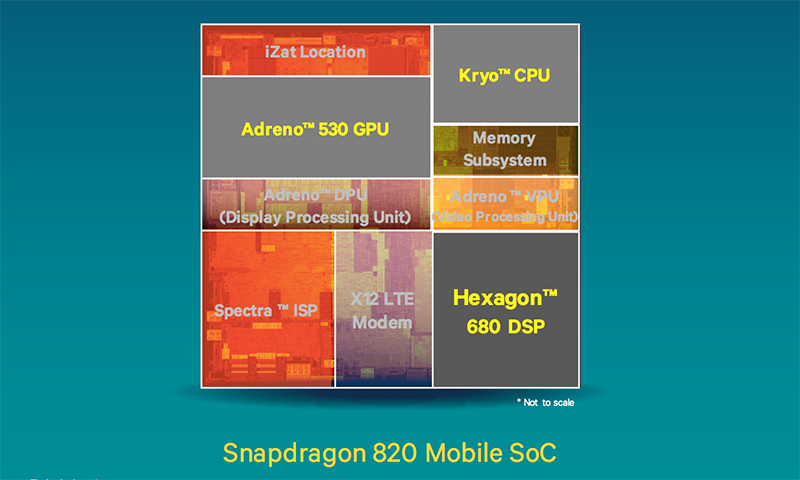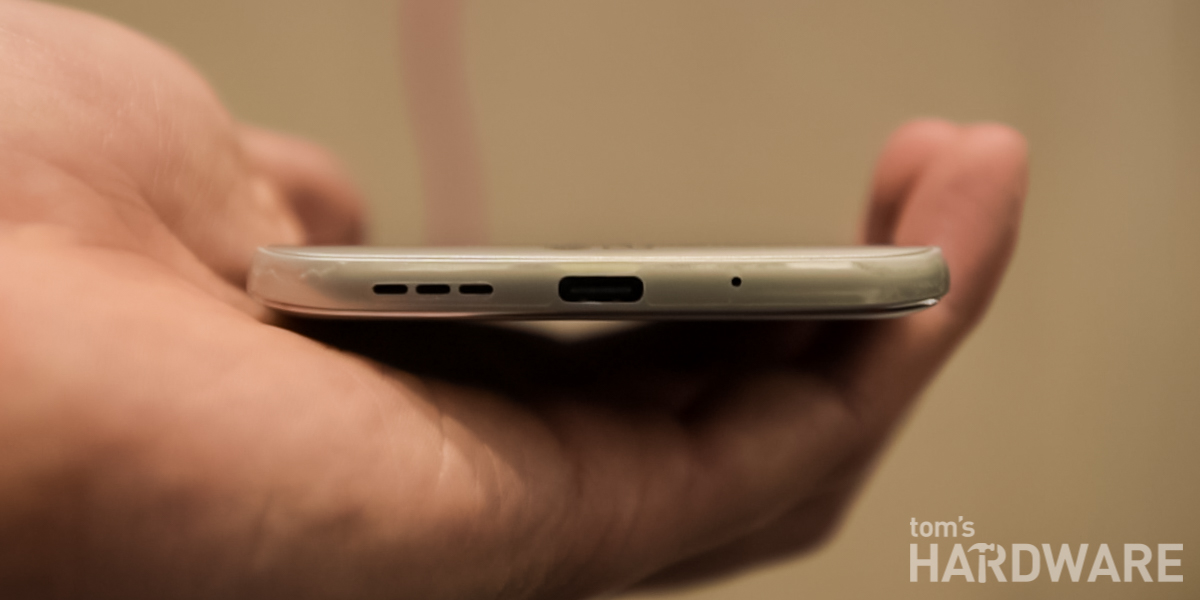LG's G5 Shows Bold Mobile Move, We Go Hands-On
Hardware Specifications
| SoC | Qualcomm Snapdragon 820 64-bit Processor |
|---|---|
| CPU | Qualcomm Kryo (2 x @ 2.15 GHz + 2 x @ 1.59 GHz) |
| GPU | Qualcomm Adreno 530 @ 624MHz |
| Display | 5.3-inch Quad HD IPS Quantum Display (2560 x 1440, 554ppi) |
| Memory | 4 GB LPDDR4 RAM, 32 GB UFS ROM, microSD slot (up to 2 TB) |
| Camera | Rear:Standard Lens: 16MP, 1/2.6" Sony IMX234 Exmor RS, 1.12μm, f/1.8, 28mm, Laser AF, OIS 2.0, HDR, color spectrum sensor, LED flashWide Lens: 8MP, f/2.4Front: 8MP |
| Battery | 2,800 mAh (removable) with Qualcomm Quick Charge 3.0 |
| Biometrics | Rear-mounted Fingerprint Sensor |
| Operating System | Android 6.0 Marshmallow with LG UI |
| Size & Weight | 149.4 x 73.9 x 7.7 mm, 159g |
| Network | X12 LTE Modem with Cat. 12 download (up to 600 Mbps), Cat. 13 upload (up to 150 Mbps) |
| Audio | aptX HD 24-bit Hi-Fi Wireless Audio |
| Connectivity | Wi-Fi 802.11 a, b, g, n, ac, USB 2.0 Type-C, NFC, Bluetooth 4.2 |
| Materials | Aluminum, Gorilla Glass |
| Colors | Silver, Pink, Titanium, and Gold |
| Carriers | TBA |
| Pricing | TBA |
A Brief SoC History Lesson
In 2015, Qualcomm’s flagship SoC, the 64-bit octa-core Snapdragon 810, was plagued with problems, especially when it first launched. To catch up with the competition (Apple), Qualcomm wasn’t able to design its own custom CPU cores fast enough and ended up using ARM’s reference Cortex CPUs in its 2015 chips. The problem with the 810 was it used four power-hungry Cortex-A57 cores built with TSMC's 20nm HKMG process. The 810 ran hot because of this, and thermal throttling had to be used to keep its heat in check, which resulted performance that was not much better than its predecessors.
LG had used the 810 in its first 2015 phone, the G Flex 2, so when it came time to pick the SoC for the G4, it was well aware of the 810’s issues. Instead, LG opted to use the step-down chip, the hexa-core Snapdragon 808, and although it was built on the same process as the 810, it only had two A57 cores, which minimized the thermal issues. In practice, that meant from a CPU performance perspective that the 808 performed just as well as its bigger brother, as our testing of the LG G4 showed.
What the 808 didn’t have was as good as a GPU as the 810, nor did it support higher bandwidth DDR4 RAM. So while its CPU was able to keep up with the competitor’s flagships, the G4 was underpowered graphically, with the Adreno 418 GPU sometimes not being adequate for its QHD display.
Powered by Qualcomm’s Latest And Greatest
For 2016, LG has gone back to using Qualcomm’s most powerful SoC in its flagship phone -- the new Snapdragon 820. The 820 uses Qualcomm’s “first custom-designed 64-bit CPU,” the Kryo, designed for heterogeneous computing, which combines the abilities of all the SoC’s processors (CPU, GPU, DSP, and ISP) to maximize performance while minimizing power use. One example of how the 820 uses heterogeneous computing is combining the power of the CPU and GPU to speed up video post-processing, and both Qualcomm and LG claim that this allows for double the performance with 40 percent less power consumption. The thermal issues of the 810 are a thing of the past, with the 820 using Samsung’s more efficient 14nm FinFET LPP manufacturing process.
Also, the Snapdragon 820 is equipped with Qualcomm’s latest and most powerful GPU yet, the Adreno 530. Unfortunately, we don’t know too much about its architecture, other than it runs at up to 624 MHz. It should be faster than the already fast Adreno 430 found in the 810, and LG claims 40 percent improvement in both performance and power efficiency. The 530 also supports the new next-generation Vulkan graphics API. There is also the new lower-power Hexagon 680 DSP and the new Spectra 14-bit dual ISPs. Cellular connectivity is enhanced by the X12 LTE modem that supports Category 12 LTE download speeds of up to 600 Mbps.
Each of the 820’s chips is significantly faster than the previous generation, but when working together through heterogeneous computing, they can power through tasks even faster while still saving power. Qualcomm has designed the 820 to be able to apply its performance to optimizing demanding applications like virtual reality, computer vision, 4K capture and playback, and advanced image processing, all of which will significantly benefit the G5. As you’ll read later on, the G5’s dual cameras and add-on VR headset will all be able to utilize the 820’s enhancements.
If you want to learn more about the Snapdragon 820, you can read our detailed performance preview. We were certainly impressed by it, but our testing was done on Qualcomm's Mobile Development Platform (MDP), so isn’t totally representative of how a shipping device like the G5 will perform.
Get Tom's Hardware's best news and in-depth reviews, straight to your inbox.
Part Of LG’s DNA: MicroSD And A Removable Battery
The G5 has 32 GB of faster UFS (Universal Flash Storage) internal storage, which is step up from the G4’s slower eMMC storage. With the G5 also having a microSD slot, you should be able to use Marshmallow’s new adoptable storage option (if LG has enabled this feature) that allows you to combine both storage amounts into one pool. This will significantly simplify storage management if you use a microSD card, but once it's adopted, the card isn’t supposed to be removed.
Also, keep in mind that even the fastest U3 microSD card isn’t going to be as fast as the built-in UFS storage, so you may see a slight storage performance drop if you do this. Of course, you don’t have to adopt the SD card, and it can still be used for normal removable storage.
We’ve already covered the fact that the G5’s battery is still removable, but what we haven’t said is that it's only 2,800 mAh, which is quite a bit smaller than the 3,000 mAh batteries of the G4 and G3. This concerns us a bit because the G4’s battery life was only average. However, the G5 does have a much more power-efficient SoC and has Low Power Location Estimation (LPLE) technology, which is supposed to reduce the power consumption of location-based apps. In addition, its display is physically smaller and has smarter backlight control, so perhaps all these enhancements will allow for better battery life despite the smaller cell. The only way to be sure, of course, will be to put the G5 to the test, which we look forward to doing.
With its metal body, the G5 isn’t going to be able to support wireless charging, but what is does support is Qualcomm’s new Quick Charge 3.0 standard through its USB Type-C port (USB 2.0). LG claimed that this new standard is “27 percent faster and 45 percent more efficient than the previous generation.” Let’s hope this time round LG sees fit include a quick charger in the box with the G5 – although the G4 supported Quick Charge 2.0, the charger to utilize it was optional.
-
jgskpx0389 I'm just loving this modular battery. I'm currently using Note 5 and I love the fast charging feature but at the same time it feels like the battery drains faster than my previous phone because I have to charge during lunch time and then at night time when i'm at homeReply
with this new modular battery by LG I can finally go back to having 2 batteries and just swap them out so i don't have to charge battery at all during daytime -
LordConrad Still has a button on the back. This is the only thing keeping me from buying this phone, as I find rear buttons to be highly annoying.Reply -
l1ghtm4st3r ReplyStill has a button on the back. This is the only thing keeping me from buying this phone, as I find rear buttons to be highly annoying.
The buttons are on the side. It's only the fingerprint sensor on the back.
-
pocketdrummer ReplyStill has a button on the back. This is the only thing keeping me from buying this phone, as I find rear buttons to be highly annoying.
What's truly annoying is their insistence on ruining the android experience with their own crappy launcher. Why would anyone want to have their home screen cluttered up with every single app they own? Stupid... -
seth89 No rear rocker buttons, WTH LG!Reply
Anyone who has a LG G3,G4, or V10 gets it.
It's ugly too, I was really looking forward to the same body the G series has always had but metal not an iPhone knock off.
<-----this guy is let down. -
Chris Droste I really would have appreciated a more evolutionary step this time. I think the G5 should have been the G4(leather back and back buttons in all) with the new, slightly smaller screen, the built-in DAC from the V10, the new Snapdragon chip, improved camera software, clean up the UI bloat even more (though i still love QMemo, QuickRemote, and Dual Window) and keep the dark theme, i really don't want to get my face bleached in the dark when i pull down the notification bar. the Dark Theme was clean, good contrast and easy on the eyes. this reminds me of the stupid color removal thing on the top icons after upgrading from Jellybean (STUPID!!!) App drawer; I'm indifferent. it helps when i lose a homescreen icon after a software update but millions of iPhone users may find it's removal another ease of use to draw in former apple devotees. And for the love of god what was wrong with the 3,000mAh battery? I personally loved that curved back!Reply -
mobtus ReplyWhat's truly annoying is their insistence on ruining the android experience with their own crappy launcher. Why would anyone want to have their home screen cluttered up with every single app they own? Stupid...
I have a V10, the android version it has is actually pretty close to vanilla android... You might be thinking of Microsoft's launcher -
PortableSoftware Software Free Download Full Version with Crack & Keygen.These software suitable for all Operating System including Windows,Linus,Ma,Android etc. ..Click here to download Free == > http://crackdownload.net/Reply
http://ddlfile.com/
http://ddlforall.com/
http://fullcrackfile.com/
http://portablesoftwarecracks.com/



